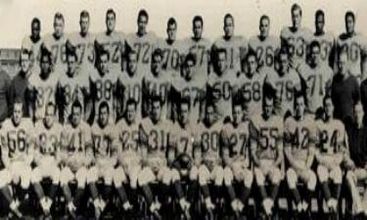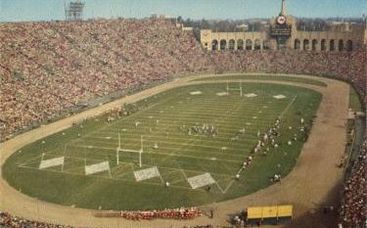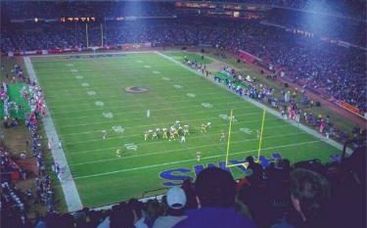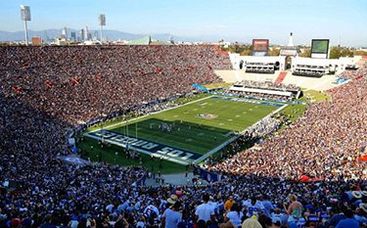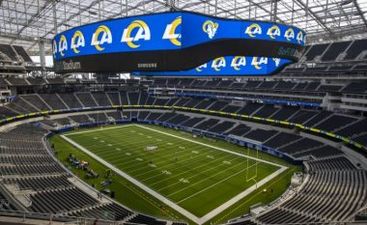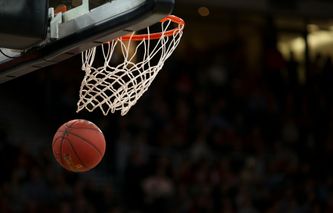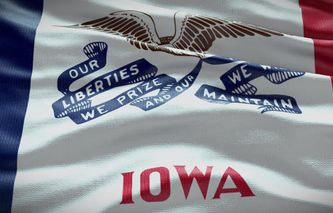
52nd Season
First Game Played September 29, 1946
Played in St. Louis 1995-2015
29899 Agoura Road Agoura Hills, CA 91301
(818) 338-0011
http://www.therams.com
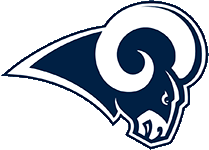 Logo 2017-Present | 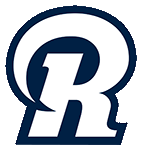 Alternate Logo 2017-Present |  |
Historical Moments
1946:With the arrival of the defending NFL Champion Rams, Los Angeles finally had a major professional team. The NFL once expiremented with a team based in Los Angeles, but they played all their games on the road. The new Los Angeles Rams proved to be ahead of their time right away as they signed halfback Kenny Washington, and Wide Receiver Woody Strode. The two became the first black players to play in the NFL since the NFL instituted a ban on black players in 1932. On September 29th the city of Los Angeles hosted its first game at the historic Los Angels Memorial Coliseum, which hosted the 1932 Olympics. In the first official NFL game at the Coliseum the Rams were defeated by the Philadelphia Eagles 25-14. After a win and a tie oh the road, the Rams got their first LA win on October 20th against the Detroit Lions. However, the Rams would lose three of their next five games, as hopes for a repeat NFL Championship faded. The Rams would close their first season in Los Angeles with a 6-4-1 record.
1947:Owner Dan F. Reeves assumes General Manager duties after Charlie Walsh reigns. He would name Bob Snyder to replace Coach Adam Walsh who also resigned. Under coach Snyder the Rams would be hobbled by injuries all season finishing with a 6-6 record.
1948:The Rams enter the season with a new coach and a new look. The new look comes courtesy of Halfback Fred Gehrke, an industrial design artist in the off-season. Gehrke had designed yellow horns on the side of the helmet making the Rams the first NFL team to have a team insignia or logo on their helmet; by 1960 all teams with the exception of one would have it. The new look Rams were led on to the field by Charles Shaughnessy when Bb Snyder resigned 19 days before the start of the season. After winning and tie their first two games the Rams struggled mightily losing four of five games. However, the Rams would finish strongly by winning four of their last five games to post a 6-5-1 record.
1949:The Rams get off to a flying start winning their first six games. The winning streak was capped by a 27-24 victory over the Chicago Bears before a Rams record crowd of 86,080 in Los Angles Memorial Coliseum. The Rams would hold on to the Western Division Championship by going 2-2-2 over their final six games. In the NFL Championship Game played at the Coliseum heavy rain and a sloppy field combine to slow down the Rams offense as the Philadelphia Eagles win the NFL Championship with a 14-0 win.
1950:Under new coach Joe Stydahar the Rams set 22 offensive records rolling to a 9-3 record, which was good enough to earn them a first place tie with Chicago Bears for the Western Division Championship. A high flying passing game with star recievers Tom Fears, and Elroy “Crazy Legs” Hirsch keyed the Rams offensive power. The Rams failed to score 30 in only four of their 12 games that included a 70 point and 65 point performance in consecutive weeks. In the Division Championship the Rams got revenge for two earlier losses by beating the Bears 24-14 to advance to the NFL Championship Game. In the Championship Game the Rams returned to Cleveland to face the Browns. The Rams and Browns would battle back and forth all game before Lou Groza’s late field goal gave the Browns a 30-28 win.
1951:Norm Van Brocklin assumes duties at Quarterback as the Rams offense continues to be the best in the NFL. The Rams would break the 40-point mark six times while compiling a 9-3 win for the Western Division Championship. In the NFL Championship Game the Rams earned a rematch with the Cleveland Browns, with the game being played in the Coliseum. The game was tied at 17 until Van Brocklin hit Tom Fears with a 73-yard bomb to give the Rams a 24-17 win, and the city of Los Angeles its first Major Sports Championship.
1952:After a 37-7 season opening loss in Cleveland to the Browns, coach Joe Stydahar suddenly reigned; he would be replaced by Hampton Pool. Under Pool the Rams lose two of their first three games getting uses to a new system. However, once the Rams got acclimated to their coach they would begin to fire on all cylinders winning their final eight games to earn a tie for the Division title with Detroit Lions. However, the Rams season would end with a 31-21 loss to the Detroit Lions in the Division Playoff game.
1953:The Rams would post an impressive 8-3-1 record, while finishing in third Place in the Western Division. However, they were left to wonder what if as they lost by a total of eight points in their three losses.
1954:After a disappointing 6-5-1 season, Hampton Pool and all the Rams assistant coaches resign. Pool would be replaced by University of Cincinnati coach Sid Gillman.
1955:In Sid Gillman’s first year as Head Coach the Rams use tough defense and clutch Field Goal kicking from Les Richter to capture the Western Division Title with an 8-3-1 record. Previously Richter was best known for the 1952 trade in which the Dallas Texans traded him to the Rams for 11 players. In the NFL Championship Game the Rams would be defeated by the Cleveland Browns 38-14 at the Coliseum.
1956:After winning their first game of the season the Rams struggle mightily losing eight of their next nine games, on their way to a 4-8 record, for their first losing season since moving to Los Angeles.
1957:Former Rams publicist Pete Rozelle assumes General Manager duties as the Rams play mediocre football on the way to a 6-6 season. The season would be highlighted by a November 10th 37-24 win over the San Francisco 49ers in which a regular season record 102,368 fans attend the game at the Coliseum.
1958:After a preseason trade sent Quarterback Norm Van Brocklin to the Philadelphia Eagles, Bill Wade steps in and sets several team passing records, as the Rams finish the season with a solid 8-4 record.
1959:Despite a strong season from powerhouse Fullback Ollie Matson, the Rams struggle through a 2-10 season their worst since their very first season in 1937. Following the disappointing season in which the Rams lost their last eight games, Head Coach Sid Gillman resigns.
1960:After the death of NFL Commissioner Bert Bell, Rams General Manager Pete Rozelle is named to replace him. Rozelle would hold the position for nearly three decades making the NFL the biggest sports league in the world, and becoming one of the most powerful men in sports history. Replacing Rozelle, as General Manager was former Wide Receiver Elroy “Crazy Legs” Hirsch. Hirsch would name former Quarterback Bob Waterfield as the teams head coach hoping for a return to past glory. However, the Rams would struggle and finish with a 4-7-1 record.
1961:In a year of transition the Rams trade Bill Wade, Del Shofner, and John Guzik to the Chicago Bears, for two players and a draft pick. The Rams would go on to finish with a horrendous 4-10 record.
1962:The Rams have two of the top three picks in the NFL Draft and select Quarterback Roman Gabriel and Defensive Tackle Merlin Olsen. The two would go on to star for the Rams for the next decade. However, their first season was one to forget as the Rams only win one game in a miserable 1-12-1 season.
1963:After a 0-5 start Roman Gabrielle gets back his starting Quarterback job and leads the Rams to a 5-4 record in the final nine games of the season. That year also saw the Rams acquire Rosey Grier form the New York Giants. Grier would join Merlin Olsen, Deacon Jones, and Lamar Lundy to form the original Fearsome Foursome.
1964:Deacon Jones unofficially records first 20-sack season in league history with 22, as the Rams defense begins to grab headlines. However the Rams would still struggle to finish with a 5-7-2 record.
1965:After winning only one of their first ten games, the Rams take three of their last four games against the top teams in each conference. However coach Harland Svare is dismissed following the season.
1966:After a court fight, George Allen is released by George Halas from his assistant coaching duties with the Chicago Bears to become head coach of the Rams. In Allen’s first season the team shows some promise posting an 8-6 record, ending a seven year string of losing seasons.
1967:The Rams get off to a quick start by winning their first three games. The Rams winning streak would come to an end in Week 4 with a 27-24 loss to the San Francisco 49ers at the Coliseum. After the Rams tied the next two games, they picked up right where they were at the start of the season and won their last eight games to capture the Coastal Division Championship with a 11-1-2 record. However, in the Western Conference Championship the Rams would fall 28-7 to the Packers, on the frozen tundra in Green Bay.
1968:Led by the Fearsome Foursome, the Rams set a record for the fewest yards allowed in a 14 game season, as the Rams post an impressive 10-3-1 season. However, the Rams would finish second in the Coastal Division to the 13-1 Baltimore Colts.
1969:Led by Quarterback Roman Gabriel who is the unanimous choice as NFL’s Most Valuable Player, the Rams win their second Coastal Division Title in three years with an 11-3 record. However the Rams would fall in the Western Conference Championship game 23-20 to the Vikings in Minnesota.
1970:With the AFL-NFL merger now complete the Rams find themselves in the NFC Western Division. The Rams begin the NFL’s new era with a solid 9-4-1 season, but it is only good enough for second place in the NFC West. Following the season Coach George Allen’s contract is not renewed, and he moves on to coach the Washington Redskins.
1971:On April 15th, the Rams lose their patriarch when longtime owner Dan F. Reeves succumbs to cancer. His longtime friend and business associate, William A. Barnes, becomes President and General Manager. The Rams would go through a test too playing the NFL’s toughest schedule the Rams finish with an 8-5-1 record under new coach Tommy Prothro good enough for second place in the NFC West.
1972:In a history-making move, Baltimore Colts owner Carroll Rosenbloom trades the Baltimore franchise to Robert Irsay in exchange for the Rams. Irsay had purchased the Rams from the estate of the late Dan Reeves. The transaction was completed and announced on July 14th. Rosenbloom, the most successful owner in the NFL over the last two decades, brings with him to Los Angeles Don Klosterman, Rosenbloom’s general manager in Baltimore. After 6-7-1 season, all coaches are dismissed.
1973:The Rams return to the classic blue and colors last worn in 1963, as Detroit Lions assistant Chuck Knox assumes the coaching duties. Meanwhile there is a change on the field too as Quarterback Roman Gabriel is traded away, after former San Diego Chargers Quarterback John Hadl is signed. Hadl would have a stellar season leading the Rams to a 12-2 record, which captured the NFC Western Division Championship. However, in the Divisional Playoffs the Rams would fall to the Cowboys 27-16 in Dallas.
1974:After 3-2 start, the Rams trade Quarterback John Hadl to Green Bay for five draft picks in a bold move that stuns football world. Hadl’s backup, James Harris, becomes the starter and leads the Rams to 10-4 record, for its second straight NFC West title. In the Divisional Playoffs the Rams get their first playoff win in 23 years by beating the George Allen coached Washington Redskins 19-10 at the Coliseum. However a week later the Rams would fall in Minnesota 14-10 as the Vikings earned a tip to Super Bowl IX.
1975:Led by Jack Youngblood the Rams allow the second fewest points in NFL history during a 14-game season. The strong defense paves the way to a third straight NFC West title with a 12-2 record. In the Divisional Playoffs the Rams defeat the St. Louis Cardinals 35-23 at the Coliseum. However, a week later the Rams would be stunned at the Coliseum 37-7 by the Dallas Cowboys in the NFC Championship Game.
1976:Injuries force another change at Quarterback, as rookie Pat Haden takes over the reigns. However, the Rams offense dose not skip a beat scoring a NFC high 351 points reroute to a 10-31 record good enough for their 4th straight NFC West title. In the Divisional Playoffs the Rams get a bit of revenge by beating the Cowboys 14-12 in Dallas. However a week later the Rams would fall in Minnesota 24-13 to the Vikings.
1977:The Rams acquire legendary Quarterback Joe Namath from the New York Jets, however due to injury he sees hardly any action on the field. Meanwhile, seating capacity at the Coliseum is reduced from 91,038 to 71,039, as the Rams win the fifth straight NFC West Title with a 10-4 record. However, the Rams would make a quick exit in the playoffs losing to the Minnesota Vikings 14-7 at the Coliseum.
1978:With Chuck Knox leaving to coach the Buffalo Bills, the Rams rehire George Allen. However, his tenure would end before it even begins as he fired in the preseason. With Ray Malavasi now holding the coaching reigns the Rams win their sixth straight Division Championship with an impressive 12-4 record. The Rams would advance to the NFC Championship Game with a 34-14 rout of the Minnesota Vikings at the Coliseum. However, a week later the Rams would be embarrassed at the Coliseum 28-0 by the Dallas Cowboys in the NFC Championship Game.
1979:On April 2nd owner Carroll Rosenbloom dies and ownership of the Rams is turned over to widow Georgia Frontiere. The Rams limped through most of the season and sat 5-6 through the first 11 games. An injury to Quarterback Pat Haden forced an inexperienced Vince Ferragamo on to the field. The Rams would find away to win four straight games, and would win their seventh straight NFC West Title with a 9-7 record. With the team still banged up not much was thought of the Rams chances in the playoffs. However the Rams would play inspired football in stunning the Cowboys 21-19 in Dallas. Pushing to inspire the Rams was Jack Youngblood who played the game with a fractured fibula. A week later in the Rams fifth NFC Championship Game appearance in six years the Rams would finally get to the Super Bowl with a 9-0 win over the surprising Buccaneers in a rain soaked Tampa Bay.
Super Bowl XIV:Heading into Super Bowl XIV the Rams were 10.5-point underdogs to the Pittsburgh Steelers who were seeking the fourth Super Bowl Championship in six years. The Rams were still hobbling, and facing one of the greatest teams in NFL history, but they would have at least one advantage, and that would be the crowd, with game being played at the Rose Bowl in the Los Angels suburb of Pasadena. The home crowd helped the gutsy Rams hold a tenuous 19-17 lead heading into the 4th Quarter. (The Rams lead would have been larger but Kicker Frank Corral missed two PATs.) However, in 4th Quarter the Rams magic ride would come to an end as Terry Bradshaw engineered two Touchdown drives to give the Steelers a 31-19 victory over the gutsy Rams.
1980:After losing their first two games, the Rams rebound nicely and go on to post an 11-5 record as the Rams routinely sellout the cozier Anaheim Stadium. However, it is not enough for another NFC West title, and the Rams are forced to settle for a Wild Card spot. In the Wild Card round the Rams season would end with a 34-13 loss to the Cowboys in Dallas.
1981:Wendell Tyler rushes for 1,074 yards and ties Elroy Hirsch’s club record of 17 touchdowns in a season. However, the Rams struggle all season and miss the playoffs for the first time in nine years with a 6-10 record.
1982:Prior to the season the Rams acquire Bert Jones for the Baltimore Colts. However Jones struggled early and the Rams sat at 0-2 when the NFL went on strike. When the season returned two months later Jones did not fair better and was forced to shut it down after a 1-4 start. After a loss dropped the Rams to 1-5, they returned to the Coliseum for the first time in three years to face the Raiders who were playing their first season in Los Angeles. The Rams would battle the Raiders all day but would come up short in a 37-31 heartbreaker. A week later Vince Ferragamo throws for 509 yards at Anaheim against the Chicago Bears, the second highest game in league history. However the Rams still lost the game. The Rams would win their last game a week later, but still finished with the worst record in the NFC at 2-7. Following the season coach Ray Malavasi is dismissed.
1983:Spearheading one of the most dramatic turnarounds in NFL history, Rams owner Georgia Frontiere hires former USC Coach John Robinson in February, while a revamped front office engineers a dozen off-season trades, as Eric Dickerson is drafted in first round. John Robinson installs new offense (single back) and new defense (3-4-4) as the Rams finish with a 9-7 record, good enough for a Wild Card berth. In the Wild Card game the Rams defeat the Cowboys 24-17 in Dallas, to advance to the Division Round. However a week later the Redskins would humiliate them 51-7 in Washington.
1984:Led by Eric Dickerson who establishes a new NFL single season record with 2,105 yards rushing the Rams make the playoffs for the second year in a row with a solid 10-6 record. In the Wild Card game Anaheim Stadiums plays host to its first playoff game as the Rams are stunned by the New York Giants 16-13 in front of a record crowd of 67,03.
1985:An improved defense and special teams play key roles in the Rams reclaiming the NFC West title with an 11-5 record. Among the many highlights of the season is Ron Brown, who electrifies the Anaheim Stadium crowd by returning two kickoffs for touchdowns against Green Bay Packers to tie NFL record in Week 12. In the Divisional Playoffs the Rams would shutdown the Dallas Cowboys 20-0 for their first playoff win at Anaheim Stadium, as Eric Dickerson sets NFL playoff record by rushing for 248 yards. However a week later the Rams would be sacrificial lambs for the unstoppable Bears who beat them 24-0 in Chicago for the NFC Championship.
1986:The Rams acquire rookie Quarterback Jim Everett from the Houston Oilers prior to the season. Everett’s debut would come in Week 10 when he touchdown passes in a 30-28 loss at home to the New England Patriots. Everett would go on to start the final five games of the season winning his first three games before losing a showdown in overtime to Dan Marino and the Miami Dolphins. The Rams would also lose their final game of the season with division on the line, but with a 10-6 record the rams made the playoffs for the fourth straight season. In the Wild Card game against the Redskins the Rams would fall 19-7 in Washington as Jim Everett got a cold taste of reality in his first playoff game.
1987:The Rams stumble out pf the gate losing their first two games before a player’s strike forced the NFL to use replacement players. The Rams scabs would go 1-2. When the Rams regulars returned things were not much better as they fell to 1-5 with a 30-17 loss in Cleveland to the Browns. However the biggest stunner would come a few days later when the Rams traded Erick Dickerson to the Indianapolis Colts in a three team trade in which the Rams acquired six draft picks. The Rams would lose their next two games and sat at 1-7. However, the Rams would win five straight games as Charles White filled in Dickerson’s shoes quiet nicely winning the NFL rushing title with 1,374 yards rushing. However, the Rams would miss the playoffs with a 6-9 record.
1988:The Rams jump out of the gate fast by winning their first four games. After taking three of their next five the Rams sat in first place with a 7-2 record. However, four straight losses would send the Rams reeling out of first, and in danger of missing the postseason. However they would right their ship and would close the season with three wins to finish with a Wild Card spot with a 10-6 record. In the Wild Card game the Rams would be no match for the Vikings who beat the Rams 28-16 in Minnesota.
1989:The Rams get off to another fast start winning their first five games including an early season showdown with 49ers in San Francisco. However in a repeat of the previous season the Rams would lose their next four games. Once again the Rams would recover to make the playoff by winning six of their final seven games, but once again had to settle for a Wild Card. In the Wild Card game the Rams stun the Eagles on a soggy day in Philadelphia 21-7. A week later the Rams would battle the New York Giants in overtime where Flipper Anderson catches a long Touchdwon pass from Jim Everett to stun the crowd at the Meadowlands and send the Rams to a NFC Championship showdown in San Francisco. However, The showdown in 49ers was over quickly as the 49ers routed the Rams 30-3.
1990:Going into the season the Rams were considered a favorite to make the Super Bowl. However, a 1-4 start put the Rams behind the eight ball quickly. Unlike previous seasons the Rams would not recover, and by the time they faced the 49ers in San Francisco the Rams post season hopes were all but gone a 3-7. However the Rams restored a little pride by beating the 49ers to hand them their first loss of the season. However the Rams would not be able to revive their lost season as they missed the playoffs with a disappointing 5-11 record.
1991:The Rams stumble out of the gate again with a 1-3 start. The Rams would win their next two games to sit at 3-3 through their first six games. However, it would be their last win of the season as the Rams endured a record ten game losing streak to close out the season with a miserable 3-13 record. Following the season coach John Robinson would be fired, and replaced by former Rams coach Chuck Knox.
1992:After a 15-year absence in which he coached the Buffalo Bills, and Seattle Seahawks, Chuck Knox returns to the Rams and his young team shows some promise doubling their previous season’s win total for a 6-10 record. The highlight of the season comes on November 15th when the Rams hand the Dallas Cowboys their only home loss of the season.
1993:The Rams draft Jerome Bettis out of Notre Dame, and he pay dividends right away earning the Offensive Rookie of the Year, while rushing for 1,429 yards. However, the Rams take a step backward finishing with a 5-11 record.
1994:Prior to the start of the season, the Rams trade Quarterback Jim Everett and acquire Quarterback Chris Miller from the Atlanta Falcons. However, it was another change that had Los Angeles fans worried. With attendance lagging in Anaheim Stadium rumors of a move to St. Louis began to fly. In the midst of a 4-12 season the rumors became a reality as owner Georgia Frontiere announced her intentions to move the franchise. On Christmas Eve less then 30,000 fans showed up as the Rams lost their final game at Anaheim Stadium 24-21 to the Washington Redskins. After some initial resistance the move would be approved by NFL owners, ending the Rams 49-year history in Los Angeles.
1995-2015:Shortly after the Rams moved to St. Louis, the city of Los Angeles would be rocked again when the Raiders moved back to Oakland leaving the second largest television market without an NFL team. The NFL with 31 teams after an agreement with Cleveland, allowing Art Moddell to move to Baltimore looked to expand, and Los Angeles seemed a logical fit. However, squabbling among differing ownership groups and the city delayed these plans. The NFL was ready to add a 32nd team in 2002, but when Los Angeles had no firm plan in place, the City of Angels would lose its expected expansion to Houston as the expansion Texans replaced the Oilers who departed in 1997. This left Los Angeles without an option for expansion in the foreseeable future. Over the next decade Los Angeles became a bargaining chip for teams like the Indianapolis Colts, Minnesota Vikings, Arizona Cardinals, and New Orleans Saints to try to force their cities into building new stadiums or making extensive renovations. As the NFL reached two decades without a team in Los Angeles a plan was put together to recommit efforts for building a stadium. Two plans emerged one in Carson, with the San Diego Chargers and Oakland Raiders moving and one at the former site of Hollywood Park in Inglewood with the Rams returning to Los Angeles. The Rams who after two decades in St. Louis had grown dissatisfied with their dome and Owner Stan Kronke purchased the land of the once world famous home to horse racing in Southern California where some of Hollywood’s biggest stars hung out. Eventually at an Owner’s meeting on January 12, 2016 it was voted that the NFL would approve the Inglewood site and announce the Rams return to Los Angeles for the 2016 season. Not only was the NFL coming back to L.A. but the Rams who for 49 years had been the Hollywood stars of the gridiron were coming home. The plan would see the Rams use their old home the Los Angeles Memorial Coliseum, until their new state of the art facility was ready. It is projected that the Rams new home at the Los Angeles Entertainment Center will be ready in 2019. The Rams may also bring company as the Chargers were given an option to join them is they can’t get a new stadium in San Diego, and if the Chargers fall through the Raiders will get the option to join the Rams in the new stadium.
2016:After 21 seasons in St. Louis, the Rams came home to Los Angeles ending a two-decade period in which the second biggest market in the country did not have an NFL team. The Los Angeles Rams return was chronicled by Hard Knocks during the preseason, as Coach Jeff Fisher and his team adjusted to their new surroundings. While their new stadium was under construction the Rams played their home games at the historic Los Angeles Memorial Coliseum. With an eye on the future, the Rams traded up to select Quarterback Jared Goff. Goff started the season on the bench, as the Rams opened the year with an ugly 28-0 loss to the San Francisco 49ers on Monday Night Football. The Rams would do better in their first home game, stunning the Seattle Seahawks 9-3 powered by three field goals from Greg Zuerlein. A week later the Rams offense came alive in a 37-32 road win over the Tampa Bay Buccaneers. The Rams would eventually reach 3-1, beating the Arizona Cardinals 17-13 on a late pass from Case Keenum to Brian Quick. Returning home, the Rams suffered a letdown in Week 5, losing to the Buffalo Bills 30-19. A week later Case Keenum passed for 321 yards with three touchdowns but threw a costly late interception as they lost a lead in the fourth quarter in 31-28 defeat at the hands of the Detroit Lions. In London, Keenum was picked off four times as the Rams dropped a third straight game to the New York Giants 17-10. Following the bye, the Rams continued to struggle as they lost to the Carolina Panthers 13-10 to fall to 3-6. The Rams losing streak would end a week later in the Meadowlands as they beat the New York Jets in a lackluster battle of field goals 9-6. At 4-5 with Case Keenum struggling, the Rams decided to give Jared Goff his first against the Miami Dolphins at the Coliseum. The Rams scored on their first possession and held a 10-0 lead in the fourth but the Dolphins with two late scores rallied to win the game. It would mark the start of a seven-game skid to end the season as Goff struggled to adjust to NFL defenses. Following an embarrassing 42-14 loss to the Atlanta Falcons at the Coliseum in Week 14, Jeff Fisher was fired. John Fassel would serve as interim coach in the final three games, but the Rams could not do any better, finning the season with a record of 4-12.
2017:The Los Angeles Rams headlined the off-season by hiring new, 31-year-old head coach Sean McVay who had been an assistant on the Washington Redskins. The year began with a dominating performance in a 46-9 win over the Andrew Luck-less Indianapolis Colts. In the game, Jared Goff showed immediate improvement, passing for 306 yards. The Rams played this one without the services of defensive lineman Aaron Donald, who was holding out over a contract dispute with the organization. Donald would return in Week 2 of the season as the Rams fell in a heartbreaker on the road to the Washington Redskins 27-20. The game included a Todd Gurley hurdle for a touchdown and ended on a Jared Goff interception during a two-minute drill in the fourth quarter. The Rams then won a barnburner in San Francisco on Thursday Night Football beating the 49ers by a score of 41-39. The backfield of Todd Gurley, who shined in this game with 149 all-purpose yards and three total touchdowns, and Jared Goff, going 22/28 in the air with 292 yards and three touchdowns, lead the Rams all game. However, the game did end on an Aaron Donald sack as time expired. The Rams continued to put up points as they won another scorcher 35-30 against the Dallas Cowboys in Defensive Coordinator Wade Phillips’ return to Dallas. The Rams returned to the Coliseum in Week 5 as they lost another close game to the Seattle Seahawks. Cooper Kupp had a tear-jerking touchdown drop in the final ten seconds of the game as the Rams lost 16-10. The Rams got back into the win column in Week 6, with a 27-17 win on the road against Jacksonville Jaguars. The game started with a bang for the Rams as Pharoh Cooper returned the opening kick 103 yards for a touchdown. The Rams took a trip across the pond to London for Week 7 to play the Arizona Cardinals and were clicking on all cylinders in this one winning 33-0. The Rams played well on both sides of the ball, with Goff throwing and rushing for a touchdown and the defense registered three sacks and forced three turnovers. Fresh off a bye, the Rams with a 5-2 record, traveled to play the New York Giants for Week 9. The Rams continued their offensive onslaught in a 51-17 win. The game included a 52-yard touchdown on a third and 33 play where Goff hooked up with Robert Woods on a screen pass. The Rams returned to the Coliseum for the first time in a month put up another 30-point game in a 33-7 win over the Houston Texans. Woods shined in this one with 172 yards on eight catches with a touchdown. The Rams then traveled to Twin Cities to play the Minnesota Vikings in a 24-7 loss where the Vikings shut down the Rams hot offense after Todd Gurley scored on the first series of the game. The Rams bounced back in Week 12 as they beat the New Orleans Saints 26-20 in a back and forth game at The Coliseum. Jared Goff threw for 354 yards and two touchdowns. The offense finally got back to its dominant form in a 32-16 win over the Arizona Cardinals. In a potential playoff preview, the Rams hosted the Philadelphia Eagles, losing 43-35 in a hard-fought battle. Following their loss to the Eagles, the Rams went to Seattle to play the Seahawks, and dominated the defending division champions, winning 42-7 win to send the message that the NFC West now belonged to Los Angeles. The game with capped off in the second quarter when Todd Gurley busted off a 57-yard touchdown on a third and twenty play. Gurley dominated this one, running for 152 yards and scoring four total touchdowns. The Rams would clinch the division with a 27-23 win over the Tennessee Titans in Week 16. With the NFC West clinched, the Rams sent out all backups to play the 49ers rest up for the postseason. The Rams would lose this one, 34-13, finishing the year with a record of 11-5 as Sean McVay won Coach of the Year. The offensive overhaul made by McVay had the ending up with the number one scoring offense after finishing the year before with the worst scoring offense. Todd Gurley was named Offensive Player of the Year, with 2,093 total yards from scrimmage with 19 touchdowns. The play of Gurley helped lift Jared Goff’s play, as the Rams second-year quarterback passed for 3,804 yards with 38 touchdowns and seven interceptions. On defense, Aaron Donald led the way with 11 sacks and was named Defensive Player of the Year. Written by: Cobi Estes
2017 NFL Playoffs:The Los Angeles Rams were in the playoffs for the first time since 2004 and playing their first postseason game in Los Angeles since 1985. The game didn’t go as well as the rest of the season as the Rams lost to the Atlanta Falcons, 26-13 in a game where the offense could never get anything going as the defending NFC Champions experience paid off against the young Rams, many of which were getting their first taste of postseason football. Written by: Cobi Estes
2018:Entering year two of the Sean McVay era, the Los Angeles Rams looked to improve even more after their 11-5 record and first playoff berth since 2004. During the off-season, the Rams looked to bolster their roster with dynamic playmakers by signing DT Ndamukong Suh and acquiring WR Brandin Cooks and CB Marcus Peters via trades. The Rams started the season hot, winning their first eight games, as their up-tempo offense led by third-year quarterback Jared Goff racked up points. The Rams streak ended with a 45-35 loss to the New Orleans Saints at the Superdome in Week 9. The Rams were in many shootouts, including the game of the year against the Kansas City Chiefs on Monday Night Football. The Rams took home a 54-51 victory at the Coliseum in a back and forth Monday Night game against Patrick Mahomes and the Chiefs resulting in the third highest-scoring game in NFL history. The Rams went on to defeat the Detroit Lions 30-16 in Week 13 to clinch the NFL West for the second consecutive year. The Rams would finish the season 13-3, tied with the Saints for the best record in the NFC, and receive the second seed with a bye. The Rams ended the season as the second-highest points for in the season, averaging almost 33 points per game. Jared Goff passed for 4,688 yards while throwing 32 touchdowns with 12 interceptions. Goff targeted Robert Woods and Brandin Cooks often, who both finished with over 1,000 yards each. Todd Gurley, the 2017 Offensive Player of the Year, also continued to contribute on the ground racking up 1,831 total yards and 21 total touchdowns. The Rams finished with four Pro Bowl selections: Goff, Gurley, DT Aaron Donald, and ST Cory Littleton. Aaron Donald took home the Defensive Player of the Year award and the Deacon Jones award, and the Rams offensive line was awarded Built Ford Tough Offensive Line of the Year at the NFL Honors. It was the second consecutive Defensive Player of the Year for Donald, who had an NFL best 20.5 sacks.
Written by Kristopher “Topper” Korb
2018 Playoffs:After receiving a first-round bye, the Los Angeles Rams would take on the Dallas Cowboys in the Divisional Round. After getting the rust off during the first quarter, the Rams were able to control both sides of the line of scrimmage with help from running backs Todd Gurley and CJ Anderson, both rushing over 100 yards and tabbing three scores combined to help defeat the Cowboys 30-22 and advance to the NFC Championship for the first time since 2001. Against the New Orleans Saints at the Superdome, the Rams looked lost in the first quarter against the Saints going down early 13-0. However, Sean McVay was able to craft up some trickery on special teams and offense to lead the Rams back into the game, as a pass by first down pass by punter Johnny Hekker sparked life into Los Angeles, who tied the game in the fourth quarter. A blatant pass interference against the Rams was not called late in the game, which would have ultimately sent the Rams home and sent the Saints to the Super Bowl, caused chaos across the league. The game eventually went into overtime with Drew Brees harassed by Dante Fowler throwing an interception to John Johnson on the first drive to make the Rams Super Bowl dreams come true as Greg Zuerlein nailed a 57-yard field goal to win the game 26-23.
Written by Kristopher “Topper” Korb
Super Bowl LIII:The Los Angeles Rams would take on the New England Patriots in Super Bowl LIII in Atlanta. The Patriots were the Rams’ opponent back in Super Bowl XXXVI when Tom Brady upset the heavily favored Rams for his first Super Bowl ring. This time the Patriots were the favorites seeking a sixth Lombardi Trophy. This was a battle between a high scoring offense in the Rams and a physical low scoring defense in the Patriots. Neither team could get any offense going as the game was tied 3-3 heading into the fourth quarter. The Rams’ offense struggled all game as they totaled just 260 total yards. The Patriots finally broke through in the fourth quarter as Sony Michel scored on a two-yard run. The Patriots added a field and won 13-3 defeat in the lowest-scoring game in Super Bowl history.
Written by Kristopher “Topper” Korb
2019:After losing Super Bowl LIII, Sean McVay and his Los Angeles Rams looked to re-tool and head back to the big game. This would be the final season played at the iconic Los Angeles Memorial Coliseum as the team plans to move into SoFi Stadium in Inglewood, California, at the beginning of the 2020 season alongside the Los Angeles Chargers. After losing notable names such as Ndamukong Suh, Lamarcus Joyner, and Rodger Saffold in the offseason, the Rams were able to add veterans FS Eric Weddle and OLB Clay Matthews to help lead another postseason push. The Rams got off to another strong start, winning their first three games, including a 27-9 win against the New Orleans Saints in an NFC Championship rematch. However, the offense seemed to lose its touch that it had just a season ago with Jared Goff struggling to make big plays with Todd Gurley and Brandin Cooks suffering injuries that hobbled them throughout the year. In the middle of the season, the Rams upgraded their defense, adding All-Pro CB Jalen Ramsey in a trade with the Jacksonville Jaguars. Despite the trade, the Rams struggled with the Super Bowl hangover, as they lost seven games and missed the playoffs with a record of 9-7. It was a frustrating year where the tide seemed to turn away from Todd Gurley in the Rams backfield. The Rams went from second in the NFL in scoring offense in 2018 to 11th in scoring offense in 2019 as Jared Goff threw a career-high 16 interceptions. Despite the struggles, the Rams had a pair of Pro Bowl selections: DT Aaron Donald and CB Jalen Ramsey.
Written by Kristopher “Topper” Korb
Championship Teams
LA Rams Stadiums
LA Rams Memories
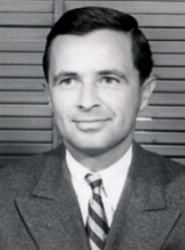 Dan Reeves Owner 1945-1971 | 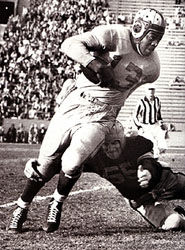 Kenny Washington 1946-1948 | 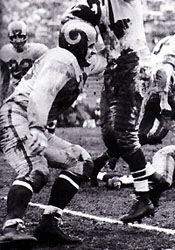 Dick Huffman 1947-1950 | 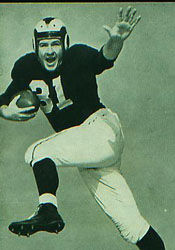 Dick Hoerner 1947-1951 | 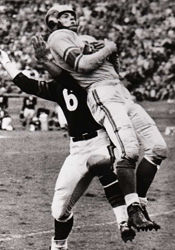 Glenn Davis 1950-1951 | 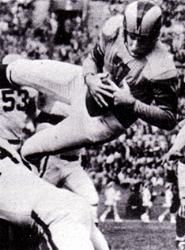 Bob Waterfield 1946-1952 |
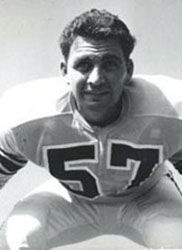 Don Paul 1948-1955 | 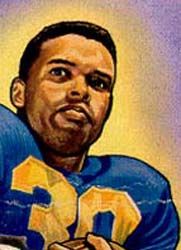 Woodley Lewis 1950-1955 | 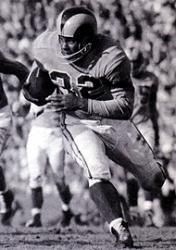 Dan Towler 1950-1955 | 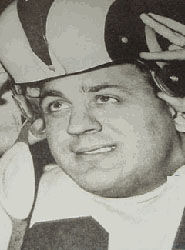 Andy Robustelli 1951-1955 | 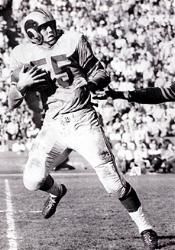 Tom Fears 1948-1956 | 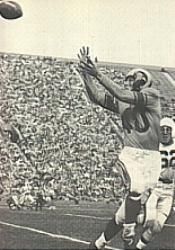 Crazy Legs Hirsch 1949-1957 |
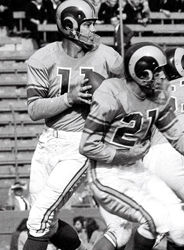 Norm Van Brocklin 1949-1957 | 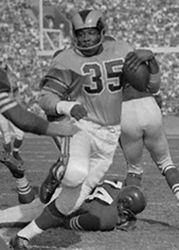 Tank Younger 1949-1957 | 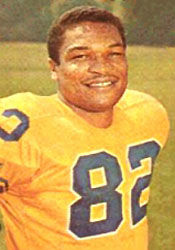 Bob Boyd 1950-1951, 1953-1957 | 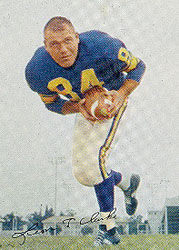 Leon Clarke 1956-1959 | 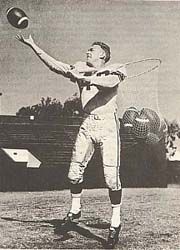 Will Sherman 1954-1960 | 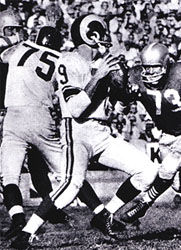 Billy Wade 1954-1960 |
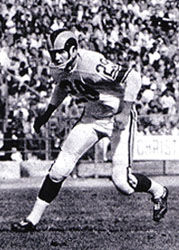 Del Shofner 1957-1960 | 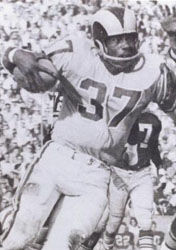 Tommy Wilson 1956-1961 | 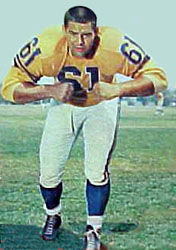 Duane Putnam 1952-1959, 1962 | 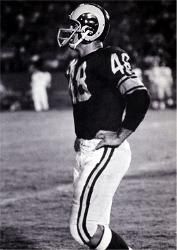 Les Richter 1954-1962 | 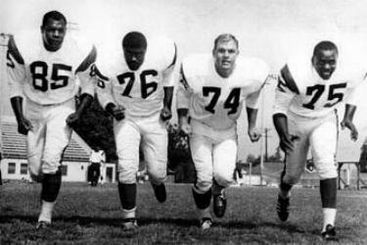 The Fearsome Foursome: Lamar Lundy, Rosey Grier, Merlin Olsen, Deacon Jones | |
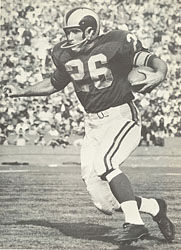 Jon Arnett 1957-1963 | 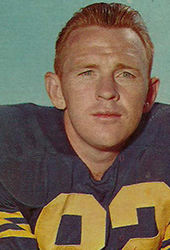 Red Phillips 1958-1964 | 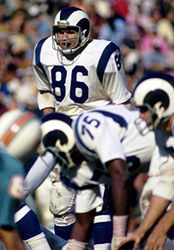 Marlin McKeever 1961-1966, 1971-1972 |  Rosey Grier 1963-1966 | 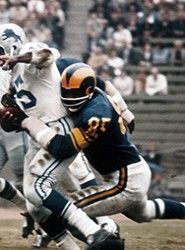 Lamar Lundy 1957-1969 | 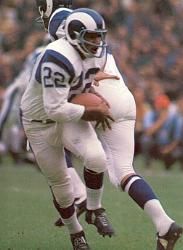 Dick Bass 1960-1969 |
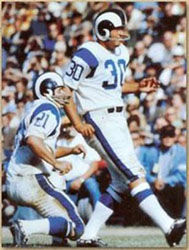 Bruce Gossett 1964-1969 | 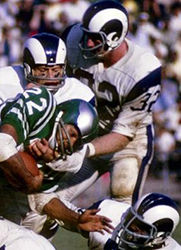 Jack Pardee 1957-1970 | 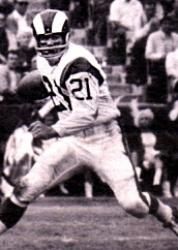 Ed Meador 1959-1970 |  Billy Truax 1964-1970 | 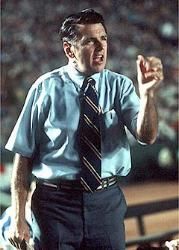 George Allen Coach 1966-1970 |  Max Baughan 1966-1970 |
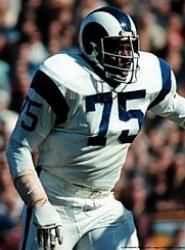 Deacon Jones 1961-1971 | 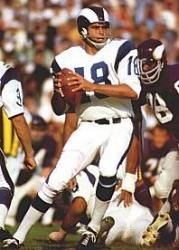 Roman Gabriel 1962-1972 1969 NFL MVP | 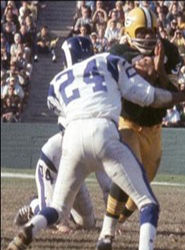 Clancy Williams 1965-1972 | 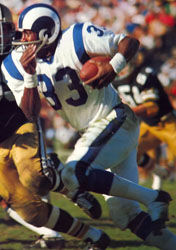 Willie Ellison 1967-1972 | 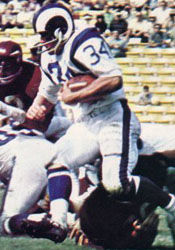 Les Josephson 1964-1967, 1969-1974 | 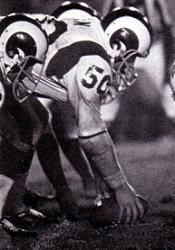 Ken Iman 1965-1974 |
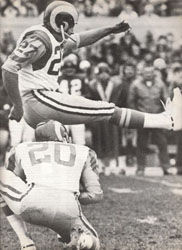 David Ray 1969-1974 | 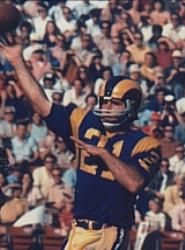 John Hadl 1973-1974 | 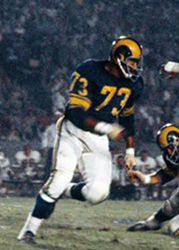 Charlie Cowan 1961-1975 | 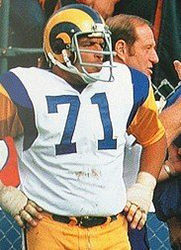 Joe Scibelli 1961-1975 | 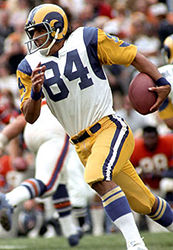 Jack Snow 1965-1975 | 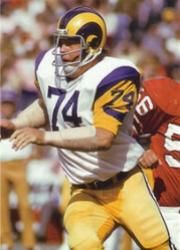 Merlin Olsen 1962-1976 |
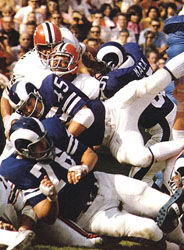 Jim Bertelsen 1972-1976 | 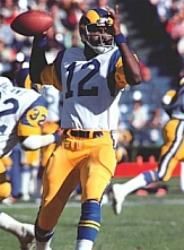 James Harris 1973-1976 | 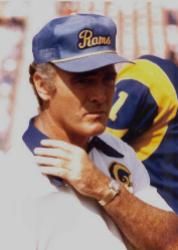 Chuck Knox Coach 1973-77, 92-94 | 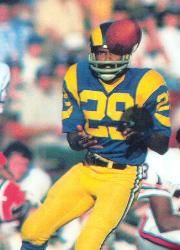 Harold Jackson 1973-1977 | 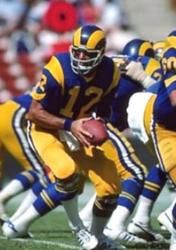 Joe Namath 1977 | 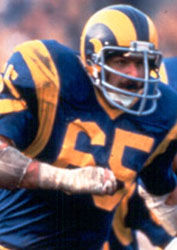 Tom Mack 1966-1978 |
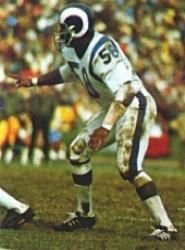 Isiah Robertson 1971-1978 1971 Deffensive Rookie | 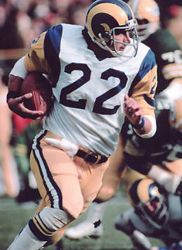 John Cappelletti 1974-1978 | 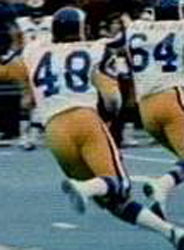 Bill Simpson 1974-1978 | 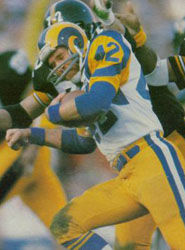 Dave Elmendorf 1971-1979 | 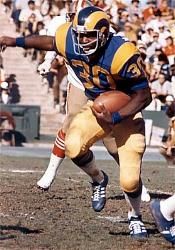 Lawrence McCutcheon 1972-1979 | 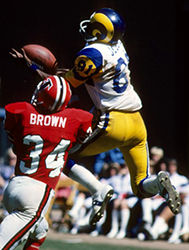 Ron Jessie 1975-1979 |
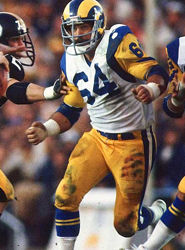 Hacksaw Reynolds 1970-1980 | 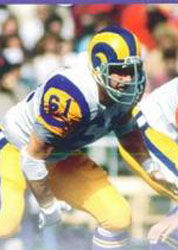 Rich Saul 1970-1981 | 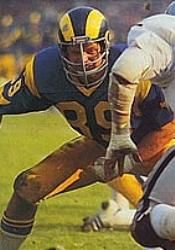 Fred Dryer 1972-1981 | 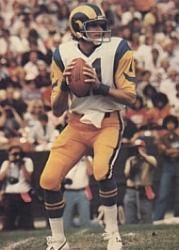 Pat Haden 1976-1981 | 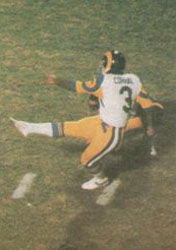 Frank Corral 1978-1981 | 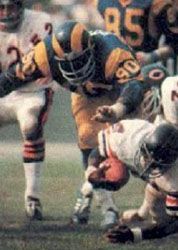 Larry Brooks 1972-1982 |
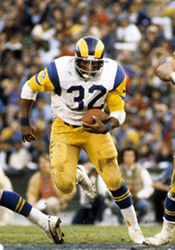 Cullen Bryant 1973-1982 | 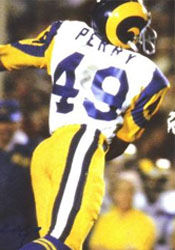 Rod Perry 1975-1982 | 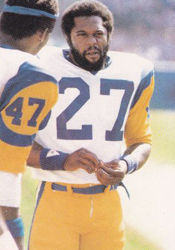 Pat Thomas 1976-1982 | 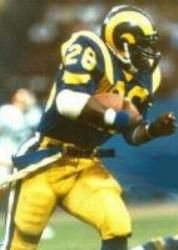 Wendell Tyler 1977-1982 | 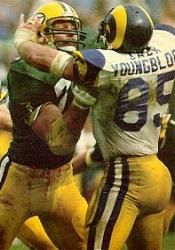 Jack Youngblood 1971-1984 | 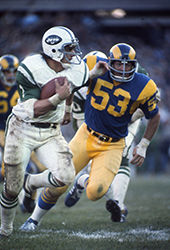 Jim Youngblood 1973-1984 |
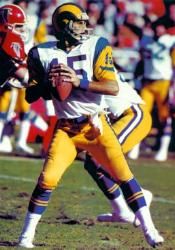 Vince Ferragamo 1977-1980, 1982-1984 | 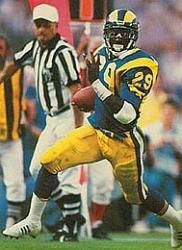 Eric Dickerson 1983 Offensive Rookie 1984 2,105 Yds Rushing | 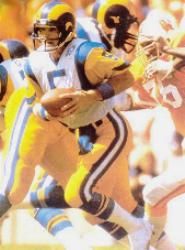 Dieter Brock 1985 | 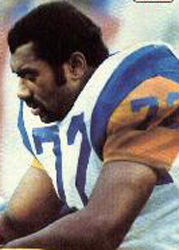 Kent Hill 1979-1986 | 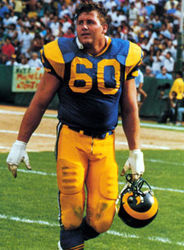 Dennis Harrah 1975-1987 | 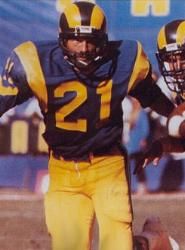 Nolan Cromwell 1977-1987 |
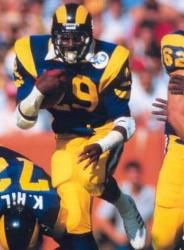 Eric Dickerson 1983-1987 | 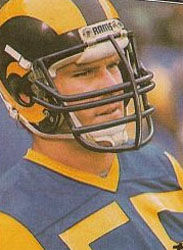 Carl Ekern 1976-1988 | 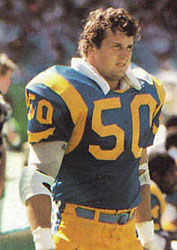 Jim Collins 1981-1988 | 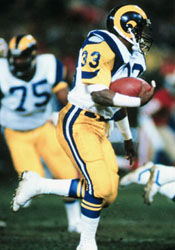 Charles White 1985-1988 | 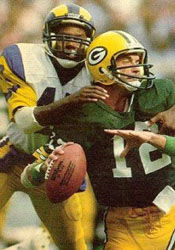 LeRoy Irvin 1980-1989 | 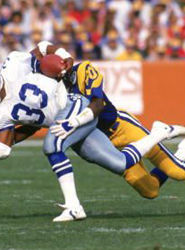 Johnnie Johnson 1980-1989 |
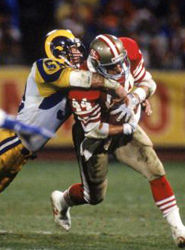 Mel Owens 1981-1989 | 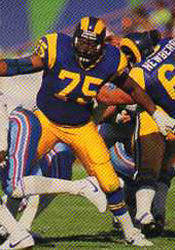 Irv Pankey 1980-1982, 1984-1990 | 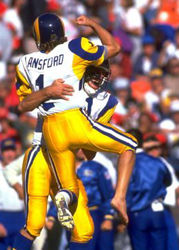 Mike Lansford 1982-1990 | 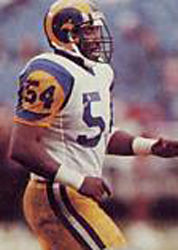 Mike Wilcher 1983-1990 | 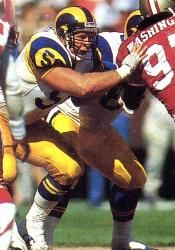 Doug Smith 1978-1991 | 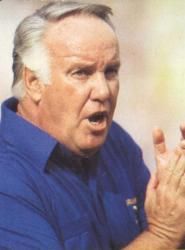 John Robinson Coach 1983-1991 |
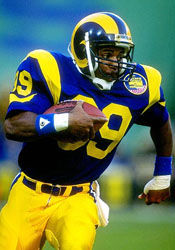 Ron Brown 1984-1989, 1991 | 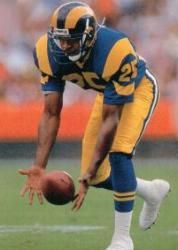 Jerry Gray 1985-1991 | 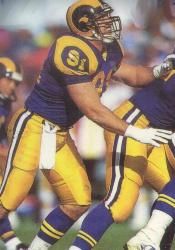 Kevin Greene 1985-1992 |  Henry Ellard 1983-1993 | 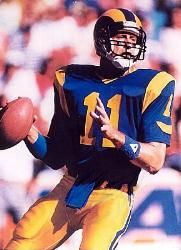 Jim Everett 1986-1993 | 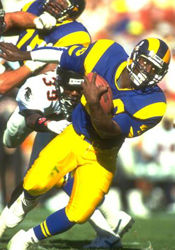 Cleveland Gary 1989-1993 |
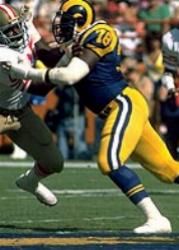 Jackie Slater 1976-1994 | 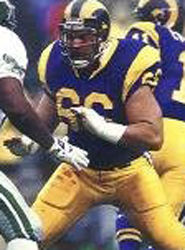 Tom Newberry 1986-1994 |  Flipper Anderson 1988-1994 | 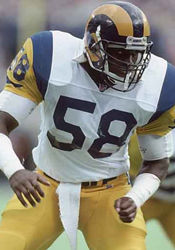 Roman Phifer 1991-1994 | 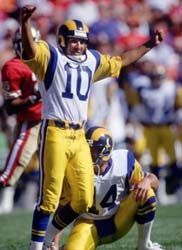 Tony Zendejas 1991-1994 | 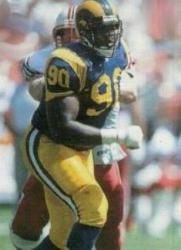 Sean Gilbert 1992-1994 |
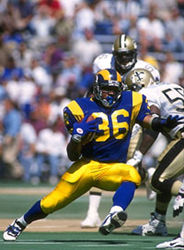 Jerome Bettis 1993-1994 1993 Offensive Rookie | 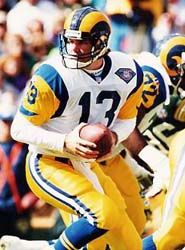 Chris Miller 1994 | 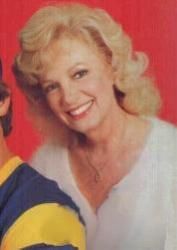 Georgia Frontiere Owner 1979-1994 | 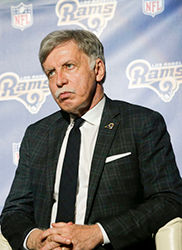 Stan Kroenke Owner 2016-Present | 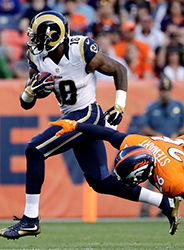 Kenny Britt 2016 | 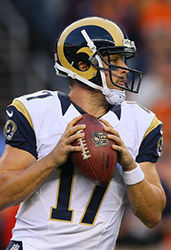 Case Keenum 2016 |
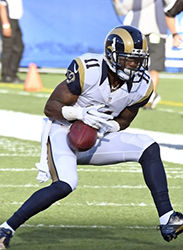 Tavon Austin 2016-2017 | 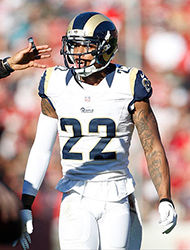 Trumaine Johnson 2016-2017 | 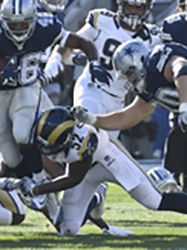 Robert Ogletree 2016-2017 | 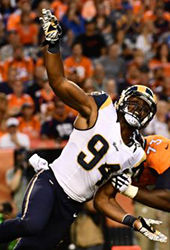 Robert Quinn 2016-2017 | 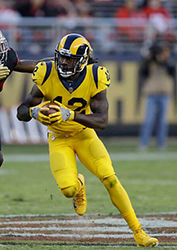 Sammy Watkins 2017 | 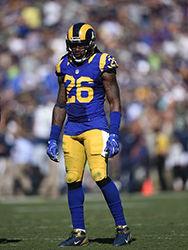 Mark Barron 2016-2018 |
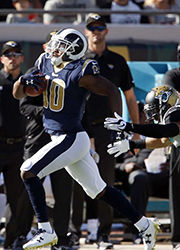 Pahroh Cooper 2016-2018 |  Lamarcus Joyner 2016-2018 | 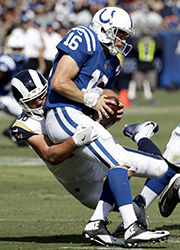 Matt Longacre 2016-2018 | 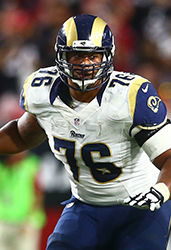 Rodger Saffold 2016-2018 | 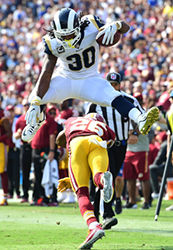 Todd Gurley 2016-2019 2017 Offensive Player | 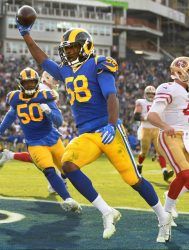 Cory Littleton 2016-2019 |
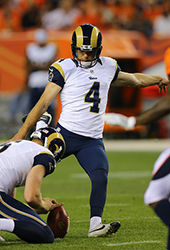 Greg Zuerlein 2016-2019 | 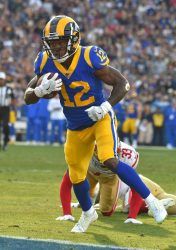 Brandin Cooks 2018-2019 | 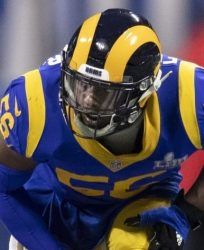 Dante Fowler 2018-2019 | 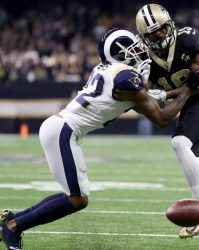 Marcus Peters 2018-2019 | 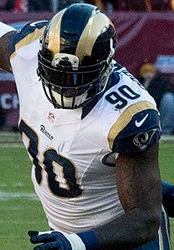 Michael Brockers 2016-Present | 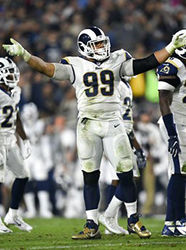 Aaron Donald 2016-Present 2017 & 2018 Defensive Player |
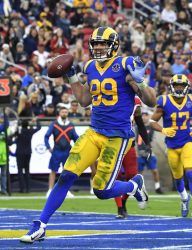 Tyler Higbee 2016-Present | 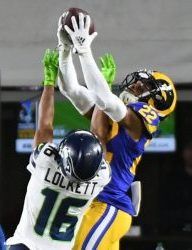 Troy Hill 2016-Present | 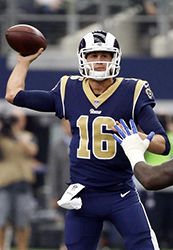 Jared Goff 2016-Present | 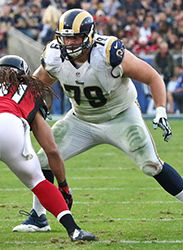 Rob Havenstein 2016-Present | 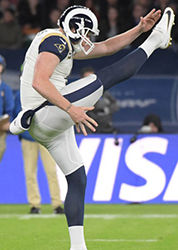 Johnny Hekker 2016-Present | 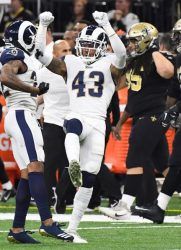 John Johnson 2017-Present |
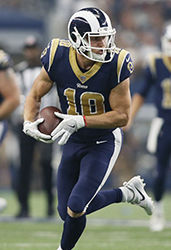 Cooper Kupp 2017-Present | 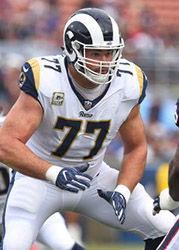 Andrew Whitworth 2017-Present | 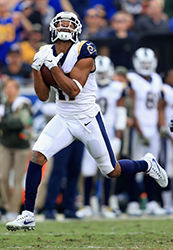 Robert Woods 2017-Present | 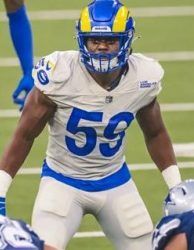 Micah Kiser 2018-Present | 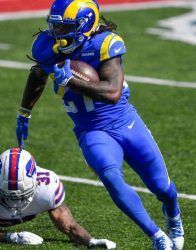 Darrell Henderson 2019-Present | 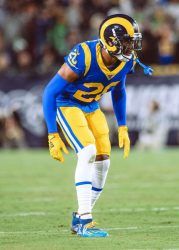 Jalen Ramsey 2019-Present |
